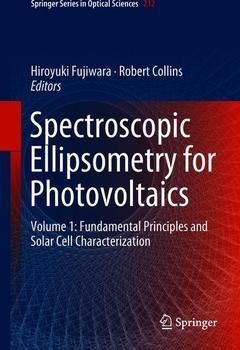Description
Spectroscopic Ellipsometry for Photovoltaics, 1st ed. 2018
Volume 1: Fundamental Principles and Solar Cell Characterization
Springer Series in Optical Sciences Series, Vol. 212
Coordinators: Fujiwara Hiroyuki, Collins Robert W.
Language: English
Subject for Spectroscopic Ellipsometry for Photovoltaics:
Keywords
Amorphous Si solar cells; CIGS growth ananlysis; Compound solar cells; Hybrid perovskites; Microcrystalline Si solar cells; Nanomaterial-based solar cells; Optical analysis of solar cells; Optical constants of solar materials; Organic solar cells; Si heterojunction solar cells; Spectroscopic ellipsometry
594 p. · 15.5x23.5 cm · Hardback
Description
/li>Contents
/li>Biography
/li>Comment
/li>
This book provides a basic understanding of spectroscopic ellipsometry, with a focus on characterization methods of a broad range of solar cell materials/devices, from traditional solar cell materials (Si, CuInGaSe2, and CdTe) to more advanced emerging materials (Cu2ZnSnSe4, organics, and hybrid perovskites), fulfilling a critical need in the photovoltaic community.
The book describes optical constants of a variety of semiconductor light absorbers, transparent conductive oxides and metals that are vital for the interpretation of solar cell characteristics and device simulations. It is divided into four parts: fundamental principles of ellipsometry; characterization of solar cell materials/structures; ellipsometry applications including optical simulations of solar cell devices and online monitoring of film processing; and the optical constants of solar cell component layers.
Introduction.- Part I: Fundamental Principles of Ellipsometry.- Measurement Technique of Ellipsometry.- Data Analysis.- Optical Properties of Semiconductors.- Dielectric Function Modeling.- Effect of Roughness on Ellipsometry Analysis.- Part II: Characterization of Materials and Structures.- Ex-situ Analysis of Multijunction Solar Cells Based on Hydrogenated Amorphous Silicon.- Crystalline Silicon Solar Cells.- Amorphous/Crystalline Si Heterojunction Solar Cells.- Optical Properties of Cu(In,Ga)Se2.- Real Time and In-Situ Spectroscopic Ellipsometry of CuyIn1-xGaxSe2 for Complex Dielectric Function Determination and Parameterization.- Cu2ZnSn(S,Se)4 and Related Materials.- Real Time and Mapping Spectroscopic Ellipsometry for CdTe Photovoltaics.- High Efficiency III-V Solar Cells.- Organic Solar Cells.- Organic-Inorganic Hybrid Perovskite Solar Cells.- Solar Cells with Photonic and Plasmonic Structures.- Transparent Conductive Oxide Materials.- High-Mobility Transparent Conductive Oxide Layers.
Hiroyuki Fujiwara received the Ph.D. degree from Tokyo Institute of Technology. He was a research associate at The Pennsylvania State University. In 1998, he joined Electrotechnical laboratory, Ministry of International Trade and Industry, Japan. Later in 2007, he became a team leader of Research Center for Photovoltaics, National Institute of Advanced Industrial Science and Technology (AIST) in Japan. He is currently a professor in the Department of Electrical, Electronic and Computer Engineering, Gifu University.
Robert W. Collins received the Ph.D. degree from Harvard University. He worked at BP America/Standard Oil Co. In 1992, he became a professor of Physics and Materials Research at The Pennsylvania State University. He is currently a Distinguished University Professor and NEG Endowed Chair of Silicate and Materials Science with the Department of Physics and Astronomy, University of Toledo. He co-directs the Center for Photovoltaics Innovation and Commercialization.
Presents ellipsometry characterization of solar cell materials/devices
Provides easy-to-understand explanations of ellipsometry data analysis
Includes optical constants for all solar-cell component layers
These books may interest you

Ellipsometry at the Nanoscale 316.49 €

Ellipsometry at the Nanoscale 316.49 €


